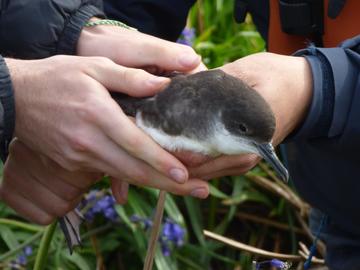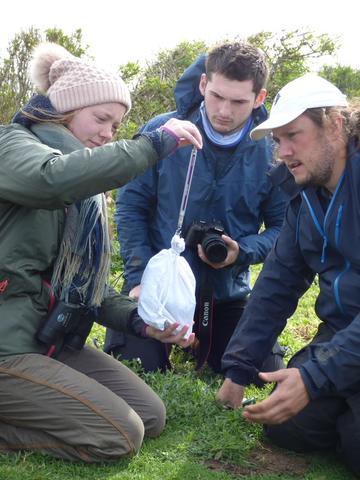Where did you go on your field course?
All second year Biology students had the opportunity to take part in a lab or field course. I chose Avian Ecology and Behaviour, which was split between Oxford and the Copeland Islands, off the coast of Northern Ireland. On the island, we stayed at the Copeland Bird Observatory. I have always had a strong interest in birds, so this was a great opportunity to actually work with them!
What did you get up to on this field course?
During the Oxford portion of the course, we focused on Passerine (songbirds and perching birds) ecology. We learned about the Wytham Tit Project, which began in 1947 and has seen tits being surveyed and monitored ever since. We went around the woods and we got to see the tit nest boxes. I had never had the opportunity to get so close to a chick before, and now I even got to see one hatch! We were also given demonstrations in skills such as mist-netting and ringing. We learned how to identify birds by their songs and calls and later had a sound analysis practical. Being able to identify birds without seeing them was a great lesson to learn!
We later visited Copeland in Northern Ireland, we spent our days out in the field, observing birds, learning about their behaviour and the various methods used to study their ecology. There were many species on the island, including the sea-going, crab-eating eider ducks; wheeling fulmars; black guillemots with their underwater displays; puffins bobbing on the sea, and a huge colony of gulls.
We learned how to observe and characterise their behaviour, and how to conduct population count estimates of them. However, the species we became most familiar with was the Manx shearwater. This

A Manx Shearwater being safely held, so that students and staff can measure their status and health
fascinating bird spends its days out at sea foraging, returns to land at night and nests in a burrow. We got bird ringing demonstrations and were able to handle the shearwaters and help to weigh them. These skills are vitally important for field biologists to learn in order to safely and ethically collect data on these birds, so we can help protect and monitor them in the future.
For monitoring studies, we learnt how to attach tracking devices such as GPS and geolocators to the shearwaters. One of the highlights was the night-time trips around the island to observe the shearwaters coming back from their trips out to sea, with the aid of infra-red binoculars, and hearing them calling to each other as they landed.
When we weren’t outdoors with the birds, we were back at the observatory getting talks about current research in sea bird ecology and behaviour. We also spent a lot of time in the common room, in front of the fire with the ukulele. Finally, an account of our Copeland adventure would not be complete without mentioning the iconic “Loo with a View”, which is nestled in the cliffs and allows you to observe puffins in the sea below. It was a firm favourite with the team!
How did this field course help your studies?
This trip was our first in-depth opportunity to conduct work in the field and learn about how research is conducted on wild animals. We were able to not only observe and try out many of these practical field skills, but also get close to the birds themselves and observe them in their natural

Students and lecturers weighing a Manx Shearwater
states. These are experiences which are often talked about in lectures but cannot be demonstrated. Seeing and doing these things has given me a deeper understanding of how ecological data is actually gathered, and some of the challenges and caveats associated with it.
One of the things which struck me the most was the creativity involved in designing the methods used for studying these birds, often not relying on standard and ready-made technologies. For example, the technique used by the Copeland researchers for surveying gulls involves marking their nests with bits of pasta. Similarly, when GPS tracking studies were begun on the shearwaters, the GPS devices used weren’t actually designed for birds, but as light-weight gadgets for tourists to geo-tag their photos. These had to be dismantled and then waterproofed in shrink-wrap plastic before being deployed.
What did you enjoy most about the course?
It is very difficult to say what I enjoyed most, because the whole trip was amazing! I think one of the highlights for me was definitely being able to observe the Manx shearwaters up-close during ringing and weighing, and in their burrows, which is not something which is ordinarily possible. One of the most exciting moments was being out at night and observing, through infra-red binoculars, the experienced ringers sneaking up on the shearwaters in order to ring them!